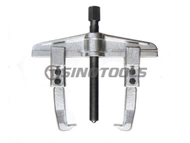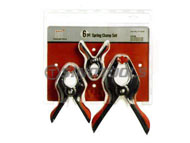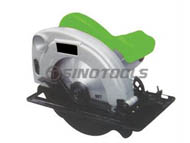Gear pullers come in various shapes and sizes and have a wide range of uses. Use the right tools when working.
Wear safety glasses or goggles, or a face shield (with safety glasses or goggles).
Choose the right gear puller for each job. Always use a gear puller of the required size or larger. If possible, use a three-jaw puller.
Make sure that the gear puller is aligned with the shaft and close to the part to be removed. The jaws should be parallel to the screws. This ensures direct pull.
Be careful when removing stubborn gears or bearings. Be sure to flatten the head of the center screw. If the gear or bearing is still stuck there after two sharp blows, choose a larger puller and continue to remove the gear or bearing.
Use a protective cap or detachable point to protect the screw from mushrooming or splitting.
If the gear puller starts to deform, stop working.
Cover the work with a cloth to protect you and bystanders from flying parts.
Before use, lubricate the center screw with engine oil.
The gear puller should be cleaned after use and stored in a dry place.

What are some things that I should avoid doing?
Do not use air-powered tools on gear pullers.
Do not use any pullers with functional parts that are excessively worn, dented, or cracked. Check the center screw for signs of wear or seizure.
Do not heat any gear puller. If heated, it loses its strength and breaks under pressure.
Do not cut or grind any part of the gear puller.
How to use a gear puller
Nothing can turn a small thing into a big one like not having the right tool and project turning into a catastrophe. Many components on the engine, transmission and transmission system are installed in a press-fit or interference fit situation where the part fits so tightly it must be pressed on. This means that when you need to disassemble gears, pulleys, bearings, etc., it may require extreme force to make the part slip off or leave its place. This is the importance of having the right tools for the job.
Most bearing or gear pullers have similar designs, they have 2-4 jaws hooks or loop ends, which can hook the items behind you want to remove, and have a center bolt or pin that can tighten down on the center of the shaft. When you tighten the bolt or pin, it pulls the bearings, gears, pulleys, etc. evenly, as if it were installed.
Clean the area-In this job, the biggest mistake you can make is to directly remove the part without cleaning the hole around the part or where the part is located. First, use compressed air and a degreaser to remove all debris from the area where the parts will slide when you pull. Also, check the area for rust and remove it with sandpaper or similar abrasives.
Install the tool-first pass the center pin out so that there is enough space for the arm of the puller to hook behind the part you want to remove. Then find the arm behind the part and tighten the center screw until the pin touches the center shaft. Most manufacturers have designed a dimple on the central shaft so that the tool can ride in it and make sure the pin is located in that recess.
Pull the part off-once you have some pressure on the central shaft to tighten it, you may not see the bearings, gears, or pulleys moving visually. Do not tighten the puller excessively, otherwise, it may cause damage. Instead, first, tighten it down with a wrench or ratchet by hand until it is very tight. Then take a hammer tap around the opening or the central shaft, or the part to help vibrate it lose.
If the parts are not loose, you may have something that is very stuck, and you may need to introduce heat.
If you cannot fully the arms of the puller behind the part, it is not common to modify or clear the arms to make them in a narrow area. Be careful not to take away too much material, because it will reduce the integrity of the arm and also will most certainly void your warranty! We are Gear puller suppliers. Please feel free to contact us if you are interested in our products.

